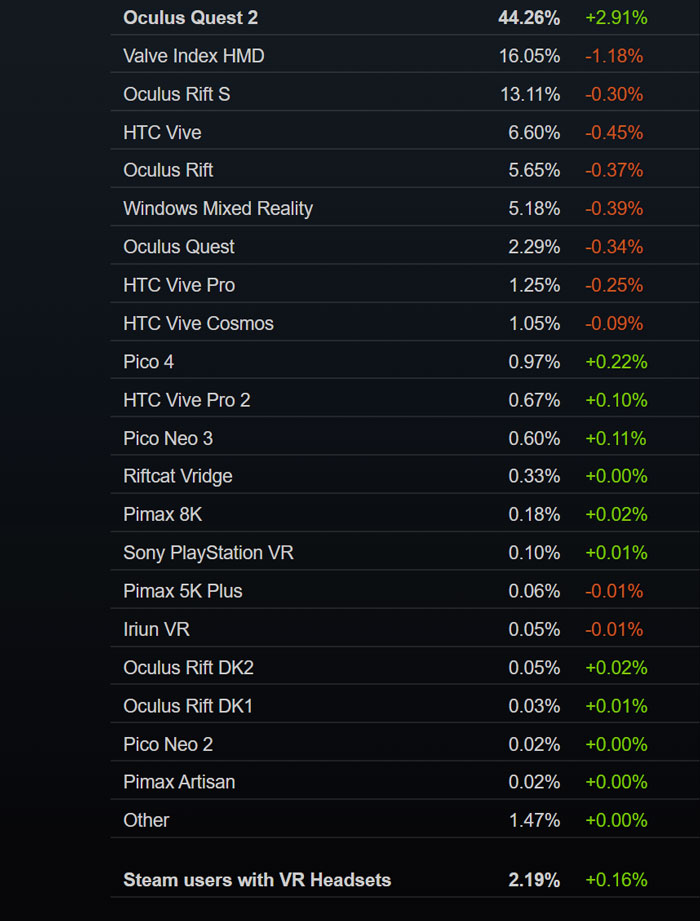Eddie-Griffin
Banned
https://news-nweon-com.translate.goog/104828?_x_tr_sl=zh-CN&_x_tr_tl=en&_x_tr_hl=en&_x_tr_pto=sc

Pico 4 was impressive in the previous charts, showing some unexpected growth, and now it's almost at 1% of headset users on Steam VR give or take the margin of error.
Quest 2 has actually increased in marketshare aby almost 3%, and every other major headset on Steam VR is actually DOWN. The biggest major headset impacted is Valve's own Index headset, dropping more than 1%. To be fair Valve did support the headset early on and then just kind of left it there, but even so it's still a strong number 2.
3 of the top 5 is still Facebook, 4 of the top 10, with HTC continuing to fail to gain ground outside of their v1 Vive headset still holding strong.
Also of note, Steam VR users themselves increased in January by 2.19%
It does look like Pico headsets are slowly climbing up the ladder. I've heard some mostly positive things about their hardware and it looks like they are gaining the interest of consumers.
Totaling by brand,
Quest headsets control ~64% of the Steam VR share.
Valve controls 16.05%
HTC headsets control ~9%
Windows mixed reality headsets ~5%
Pico headsets ~1.5%
Valve recently announced the Steam hardware and software survey data for January 2023 . Among them, or benefiting from the Christmas promotions and advertising at the end of December, the share of Quest 2 increased by 2.91%, reaching 44.26%. In addition, PICO 4 is the head display product with the second largest increase in share after Quest 2 in January.
In terms of the proportion of VR headset users, it increased by 0.16% in January to 2.19%. It is worth mentioning that, according to data from SteamDB, the number of simultaneous online users on the Steam platform exceeded 33 million at 10:00 p.m. on January 8.
The picture below is a graphic representation of the share of Steam VR in January announced by Valve Corporation:
It can be seen that Meta Quest 2 is the head display product with the largest increase in share in January, increasing by 2.91% to 44.26%. This may be due to the various promotional activities and advertising campaigns held by Meta during the Christmas period in December.
It should be noted that there have been abnormalities in Steam's statistics many times. For example, the proportion of Quest 2 in July 2022 once exceeded 50%, but later Valve stated that this was a statistical error and corrected the relevant data as shown in the table below. Then in September 2022, Quest 2's share plummeted by another 7.86% to 41.39%, and has remained around 41% since then.

Pico 4 was impressive in the previous charts, showing some unexpected growth, and now it's almost at 1% of headset users on Steam VR give or take the margin of error.
Quest 2 has actually increased in marketshare aby almost 3%, and every other major headset on Steam VR is actually DOWN. The biggest major headset impacted is Valve's own Index headset, dropping more than 1%. To be fair Valve did support the headset early on and then just kind of left it there, but even so it's still a strong number 2.
3 of the top 5 is still Facebook, 4 of the top 10, with HTC continuing to fail to gain ground outside of their v1 Vive headset still holding strong.
Also of note, Steam VR users themselves increased in January by 2.19%
It does look like Pico headsets are slowly climbing up the ladder. I've heard some mostly positive things about their hardware and it looks like they are gaining the interest of consumers.
Totaling by brand,
Quest headsets control ~64% of the Steam VR share.
Valve controls 16.05%
HTC headsets control ~9%
Windows mixed reality headsets ~5%
Pico headsets ~1.5%
Last edited:
